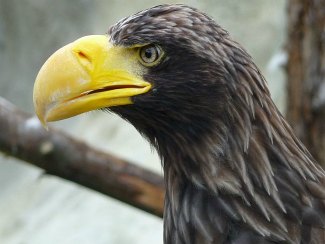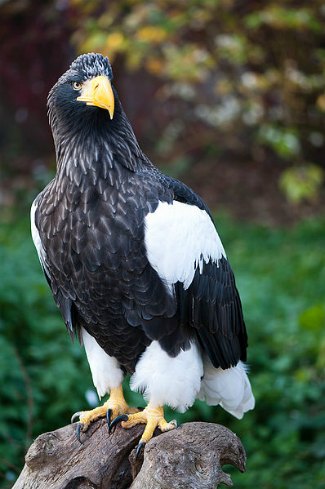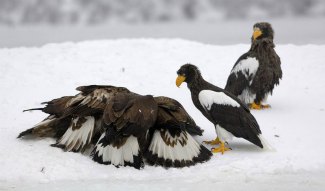Steller's Sea Eagle - Haliaeetus pelagicus
By 4028mdk09, CC-BY-SA-3.0, via Wikimedia Commons
Family: Accipitridae
Genus: Haliaeetus
Species: H. pelagicus
Steller's Sea Eagles are some of the largest eagles on the planet and the heaviest recorded. They are thought to have evolved along the northeastern coast of Asia, remaining in that region through several ice ages. They form a clade with Haliaeetus albicilla (White-Tailed Eagle), H. leucocephalus (Bald Eagle), and H. leucoryphus (Pallas’s Fish Eagle).
Physical Description:
There are two morph forms of Steller's Sea Eagles: pale morph and dark morph. Pale morphs are entirely dark brown except for a white forehead, thighs, rump, uppertail coverts, and undertail coverts, while the extremely rare dark morphs have no white on the shoulders. With both forms the eyes, cere, beak, and legs are yellow. The tail is long and wedge-shaped, the wings short, and the legs are feathered; their beaks are very large and blocky.
Juveniles are black-brown with gray streaks along the head and breast, and white mottling on the secondary feathers and wing-coverts. The eyes, cere, beak, and legs are similar to the adults', but paler.
Their barking calls have been described as "kyow kyow kyow" and "kra kra kra". Listen to a Steller’s Sea Eagle.
They can live to be over 30 years old in the wild.
Size:
Length: 85-105 cm
Wingspan: 195-230 cm
Weight: Male: 4.9-6.0 kg. Female: 6.8-9.0 kg.
By Markus, CC-BY-SA-2.0, via Wikimedia Commons
Habitat and Distribution:
They are rarely observed far apart from water and usually live along coastal habitats, lagoons, large lakes, and sometimes out on sea ice—though in Japan, 35% of the population moves inland where they forage on deer carcasses. They require supplies of fish, along with cliffs or tall trees during the breeding season. Steller's Sea Eagles are found from 0-1,000+ meters above sea level.
Their northern breeding range is in Eastern Russia along the northern Kuril Islands, the coast of the Bering Sea, the Kamchatka Peninsula, and the island of Sakhalin, from 62°N to 50°N. Their wintering grounds are in the southern Kuril Islands, the Japanese island of Hokkaido, the Sea of Japan, the Sea of Korea, the Bohai Gulf, and China, from 58°N to 42°N. Migration begins in October and they return to their breeding areas in March-April, though some populations are sedentary or nomadic. There are an estimated 5,000 individuals over a range of 1,340,000 km².
Diet and Hunting:
Steller's Sea Eagles are scavengers and their main food is fish, either alive or dead. Other prey includes albatrosses, gulls, ducks, seals, hares, cod, and a range of invertebrates such as crabs and squid. Occasionally they will take sables, red foxes, and minks from human traps.
They hunt for fish by standing in shallow water or on a sandbar, shoreline, or promontory; they also still-hunt from a perch up to 30 m high, swooping down to the water surface. Steller's Sea Eagles may circle 6-7 m above the water and catch fish in a shallow dive. They are kleptoparasites, meaning they steal food from other birds, a common trait in eagles.
Reproduction:
Breeding displays consist of soaring, calling, aerial chases, and acrobatics. The breeding season is from April-September, with nest building beginning in February-March. They probably pair for life.
The nest is built out of branches and sticks and can be up to 2.5 m across and 4 m deep, weighing over a hundred kilograms. It is placed in a tree or on a cliff around 30 m. 1-3 eggs are laid, usually 2, and are incubated for 38-45 days. Usually only one chick survives, and there are no recorded instances of three young in one nest. Fledging takes 70 days and the juvenile is dependent on its parents for 2-3 months after that. Breeding success rates are low, with 45-67% of young failing to fledge.
By Игорь Шпиленок, CC-BY-3.0, via Wikimedia Commons
Conservation:
Steller's Sea Eagles are protected in Russia, Japan, South Korea, and China, but the population is still in decline. They are threatened by coastal and oil and gas development, hydroelectric power projects, pesticides, competition with humans for fish, felling of tall trees required for breeding, lead poisoning from shots in deer carcasses, and direct persecution. They are currently listed as Vulnerable by BirdLife International.
Conservation measures proposed include closely monitoring the population, establishing feeding sites in their wintering grounds, testing the environment for DDT and PCB (polychlorinated biphenyl), and protecting fish spawning grounds.
Taxonomy:
Haliaeetus pelagicus forms a clade with Haliaeetus albicilla (White-Tailed Eagle), H. leucocephalus (Bald Eagle), and H. leucoryphus (Pallas's Fish Eagle). It’s also been found that genus Haliaeetus is closely related to the kite genera Milvus and Haliastur.
The name Steller's Sea Eagle comes from the zoologist and explorer Georg Wilhelm Steller, who lived in the 1700s. The scientific binomial name roughly translates to "eagle of the open seas".
Other Names:
Steller’s Eagle, Steller's Fish Eagle, White-Shouldered Sea Eagle, Pacific Sea Eagle, Beringshavørn (Danish), Stellers zeearend (Dutch), Hiid-merikotkas (Estonian), Kuningasmerikotka (Finnish), Pygargue empereur (French), Riesenseeadler (German), Aquila di mare di Steller (Italian), O-washi (Japanese), Baltapetis erelis (Lithuanian), Kjempehavørn (Norwegian), Bielik olbrzymi (Polish), Morskoi orel (Russian), Pigargo Gigante (Spanish), Jättehavsörn (Swedish).
Video of a Steller's Sea Eagle:
References:
Nelson, D. 2008. "Haliaeetus pelagicus" (On-line), Animal Diversity Web. Accessed April 02, 2012 at
http://animaldiversity.ummz.umich.edu/site/accounts/information/Haliaeetus_pelagicus.html
http://animals.nationalgeographic.com/animals/birds/stellers-eagle/
http://www.arkive.org/stellers-sea-eagle/haliaeetus-pelagicus/
http://avibase.bsc-eoc.org/species.jsp?avibaseid=C481FB2478D562BC
BirdLife International (2012) Species factsheet: Haliaeetus pelagicus. Downloaded from http://www.birdlife.org on
02/04/2012.
http://fadr.msu.ru/o-washinet/spsynop.html
Global Raptor Information Network. 2012. Species account: Steller's Sea Eagle Haliaeetus pelagicus. Downloaded from
http://www.globalraptors.org on 2 Apr. 2012
http://ibc.lynxeds.com/species/stellers-sea-eagle-haliaeetus-pelagicus
http://www.itis.gov/servlet/SingleRpt/SingleRpt?search_topic=TSN&search_value=175423
http://news.bbc.co.uk/earth/hi/earth_news/newsid_9036000/9036698.stm
http://www.nwf.org/News-and-Magazines/National-Wildlife/Birds/Archives/2009/Sea-Eagles.aspx
http://old.post-gazette.com/pg/11264/1176232-115.stm
Ferguson-Lees, James, and Christie, David A. Raptors of the World. Houghton Mifflin Company, 2001.
http://www.sandiegozoo.org/animalbytes/t-stellers_sea_eagle.html
http://www.zoo.org/page.aspx?pid=1530


